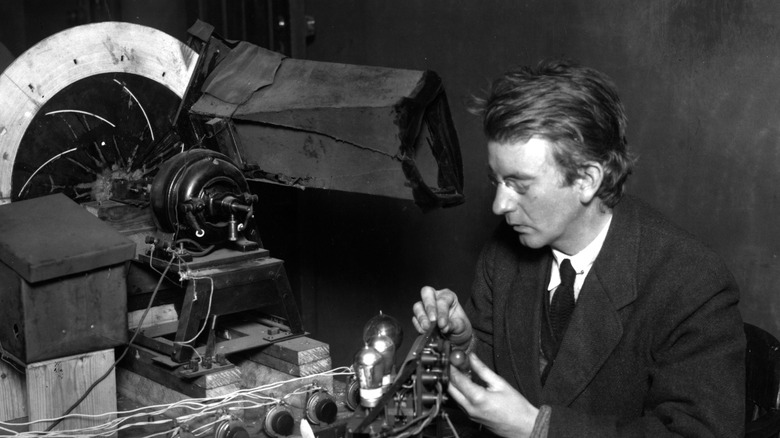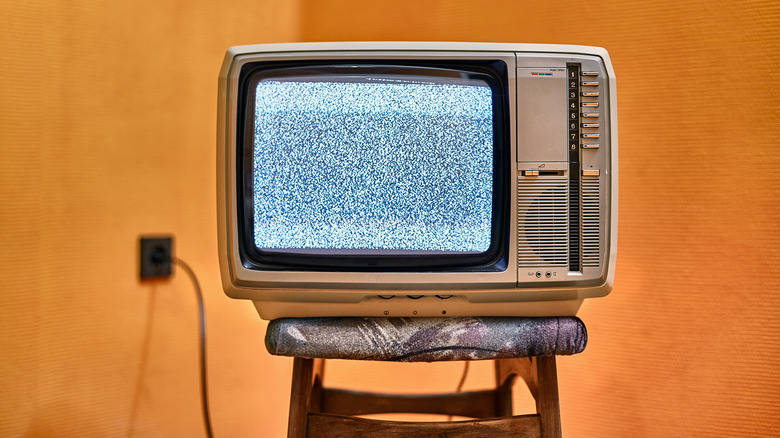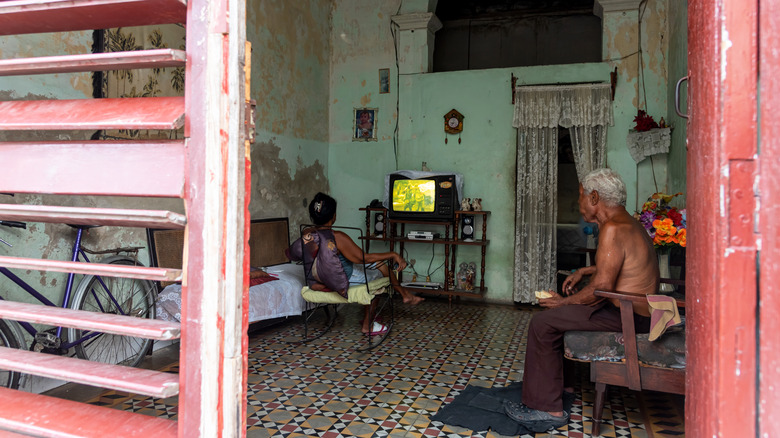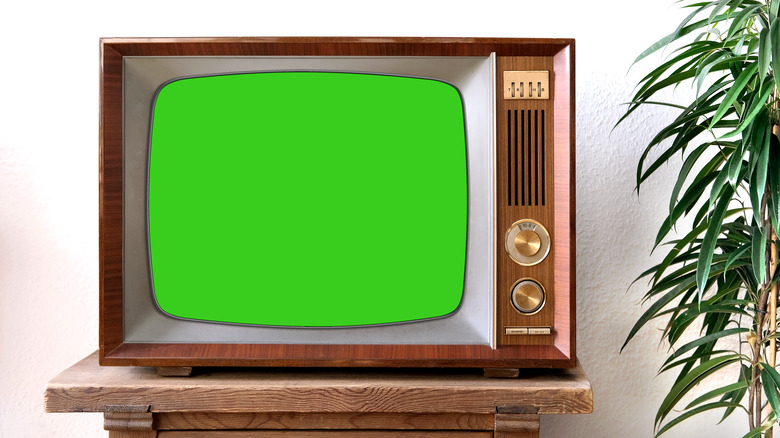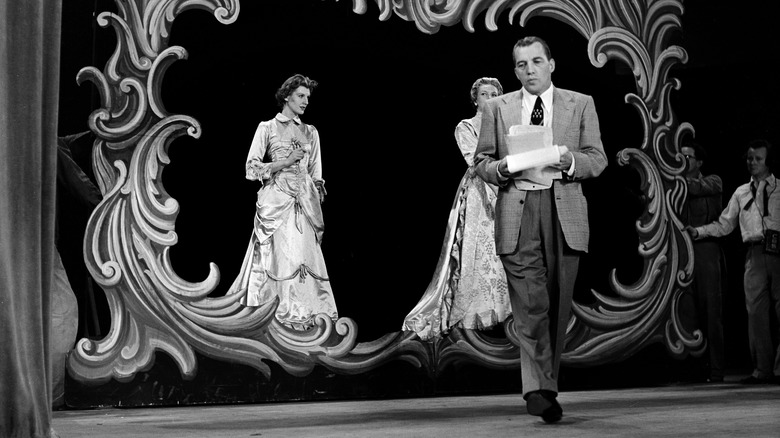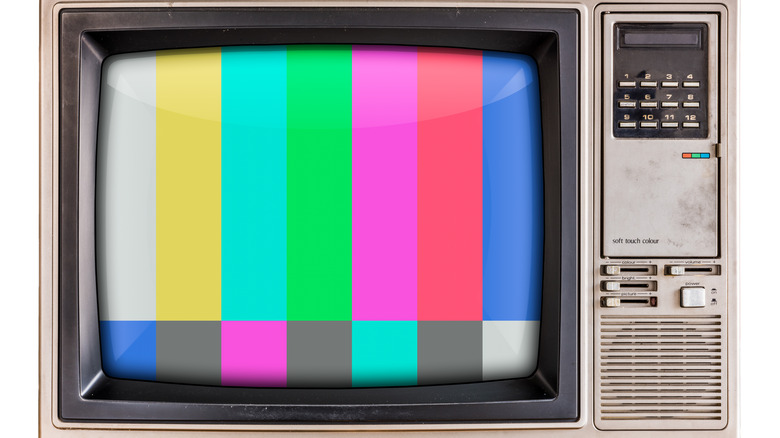What It Was Really Like To Watch The First Color TVs
You couldn't stream movies online, save favorite episodes for a rewatch, or play Spotify on your TV screen, but the first color TVs were a truly mesmerizing experience for those who were lucky enough to watch. After two devastating wars and decades of economic depression, people in the United States were eager to improve their lives at home by any means. Luckily for them, the 1950s brought several innovations in this respect, as per Google Arts and Culture: kitchen electricity (which went hand in hand with refrigerators, microwaves, and toasters), radios, and of course, color television.
As Thought Co. reports, CBS broadcasted the first regularly scheduled color TV series on June 27, 1951. It was titled "The World Is Yours!" and it was a nature documentary hosted by Ivan T. Sanderson, who traveled the world and collected various artifacts. For the first time ever, people could see animals and exciting corners of the world in vivid colors, feeling as close to them as ever. But it took a long series of conflicts, upgrades, and technological breakthroughs before people around the globe could enjoy the color television loved today. Here's what it was really like to watch the first color TVs.
The first color TV designs are much older than you think
Commercial broadcasting began temporarily in 1951 thanks to CBS, then RCA took over the market in 1953 (via Thought Co.). But although unavailable to the wide public until then, color television wasn't news. As Britannica reports, Scottish engineer John Logie Baird laid down the designs for color television as early as 1928. He was also the first person to televise pictures of moving objects in 1924 and transmit recognizable faces a year later.
Baird's color TV system entailed a Nipkow disk, as per Early Television. The Nipkow disk was divided into three separate sections, each covered by a blue, green, or red filter. The three filters would be scanned in a certain order with each rotation of the disk, thus generating a full color image. The receiving end –- the screen –- contained neon for the red light, helium for the blue one, and mercury for the green light. Baird's demonstration in 1928 was huge for science but impossible to offer to a general audience. The frame rates were very low and the images were displayed on a tiny screen that wasn't a pleasure to watch with your family at home. In fact, it took another three decades for families to enjoy color television at home.
Resolution wasn't the issue; static was
Many people assume the first color TVs had very low resolution –- after all, these TV sets were made in the 1950s, so the technology was just at its beginning, right? While technology did evolve a lot over the last seven decades, resolution wasn't necessarily an issue with the first color television sets. As per ArsTechnica, they were equipped either with NTSC (National Television System Committee), which showed 525 lines and 29.97 frames per second, or later, with PAL, which showed 625 lines and 25 frames per second. To put it in perspective, as Lifewire notes, modern standards like SDTV and HDTV are still based on the foundations of these earlier systems.
As Britannica reports, it wasn't until the 1990s that HDTV (High Definition TV) started taking over the standard systems. So between the 1950s and the 1980s, not much changed in terms of resolution. It was static (also known as noise) that was the real bugger with the first color TV sets. As the University of Toronto explains, TV sets with large antennas pick up high-frequency radio waves. This also means that the TV often ends up picking random radio signals when trying to tune in to a channel (especially when there aren't any nearby broadcasters). This is what generates the static that was such a familiar sight to the first color TV owners.
Commercial broadcasting was delayed by the Korean War
In 1950, it seemed like color television was finally becoming a viable option for households in the US. But the eager viewers enthused by this news had to wait a few good years, as the 1950-1953 Korean War intertwined with the stern competition between two broadcasting companies, CBS and RCA (via Thought Co.).
According to Thought Co., when CBS and RCA started competing for becoming the color TV pioneers, the FCC (Federal Communications Commission) tested both systems and concluded that the picture quality in RCA TVs was inferior, thus giving CBS the green light to start production. But it proved to be a mistake: It was expensive, the picture flickered, and worst of all, it was incompatible with black-and-white TV sets. Few people at the time could afford to throw out their old TVs and purchase a brand new one in the post-war era. Then, while CBS was struggling to convince manufacturers to produce color TVs, all production was halted: The government wanted to preserve resources for the Korean War.
CBS did start broadcasting in color on June 25, 1951. But they only had five east coast stations, and on top of that, RCA sued them. The Korean War ended in July 1953 (via History) and by this time, RCA had improved their system well enough to pass the FCC's test. By 1954, RCA was coordinating a large-scale color TV production and had taken over the U.S. market.
If you were in the U.S., you were lucky
In several countries, post-war austerity and bad socio-political situations meant households didn't see a color TV program until the 1960s, 1970s, or even the 1980s. Take the United Kingdom: As the Science and Media Museum reports, while the government struggled financially and couldn't decide which color TV system to adopt, all people could do was purchase a very rudimentary color filter that they could apply to their black-and-white TV sets. But the filter only worked outdoors under specific conditions, and it gave more of an illusion than a realistic depiction of the colored world (for example, it could only produce one type of skin color). The BBC started testing color TV transmissions at the Alexandra Palace in London in October 1955, but it wasn't until 1967 that the public started receiving color TV broadcasts. On July 1, British people could watch the Wimbledon championship in color for the first time.
Still, the U.K. was among the early birds when it came to color television. According to El Comercio, the Peruvian public only received color TV in 1979. And in 1983, as per Mediafax, Romania became the last European country (and one of the last countries in the world) to receive color television.
You really couldn't afford to break your TV
The first color TVs were picture tube TVs. This meant that they contained cathode-ray tubes, as per the Free Dictionary (picture tubes are also called CRT TVs for this reason). As Tech Target explains, a cathode-ray tube is a vacuum tube where electron beams strike a phosphorescent surface, creating an image. Since a vacuum is negative pressure, breaking a picture tube leads to the TV neck imploding and the screen glass exploding. As per NEDT, breaking an old color TV is extremely dangerous, and the implosion/explosion is not the only reason for this.
Picture tubes also contain between two and five pounds of lead, and color picture tubes can also contain mercury. If broken, the TV could leak these, which is toxic. Finally, CRT TVs worked at extremely high voltage — color CRTs average 27,000 volts (via NEDT), and even though the first color TVs probably held a slightly lower voltage, it still was well above the lethal level – Creative Safety Supply reports that a shock of as little as 2,700 volts can be deadly. Hence, anyone breaking their picture tube TV could end up being electrocuted to death.
With a little luck, you could get your hands on an AFC TV
Remember the constant problem with static that the first color picture tube TVs had? In the mid-1960s, Zenith TVs introduced a feature that revolutionized color TVs in the U.S. AFC, or Automatic Finetuning Control, could be activated with the flip of a tiny switch on the TV frame. When it was on, according to an ad for the TV (via Click Americana), the AFC "locked in the perfect color picture signal." This meant that the image tuned itself when the TV was turned on, then stayed tuned as the channels were changed.
Funnily enough, the Zenith commercials would often be broadcasted in black-and-white as well (via YouTube), as several households still owned black-and-white TV sets in the 1960s (via Thought Co). Their incentive that AFC is so easy to use, "you can do it blindfolded" might be questionable today. However, at the time, the AFC switch was a great upgrade to all color TVs that suffered from static whenever the channels were changed (and even during a program).
You would have probably been a fan of sitcoms and talkshows
Needless to say, watching the first color TVs meant you didn't have as much choice as Netflix offers today. In fact, there was no choice at all — during the first years of color television in the U.S., there would be only one program broadcasted at a time. According to Thought Co., the very first color TV program to be broadcasted was a variety show titled "Premiere," starring Ed Sullivan, Garry Moore, Faye Emerson, Arthur Godfrey, Sam Levenson, Robert Alda, and Isabel Bigley. All of them went on to become fairly famous talk show hosts and TV celebrities in the 1950s and 1960s. The program aired from 4:35 to 5:34 p.m. and began broadcasting in June 1951.
The same month, CBS started broadcasting "The World Is Yours!," the nature documentary presented by Ivan T. Sanderson. And in August 1951, CBS would also broadcast the first baseball game in color. Then there was a break in color TV programs due to the CBS system failing and the Korean War delaying TV production. But in 1955, the first-ever series shot entirely in color, "Norby," captivated many families in America. As per Billboard, it starred David Wayne in the role of a banker, and it started airing January 1, 1955.
If you caught the first program, you were one of the lucky few
You might be forgiven for thinking that all Americans rejoiced over the first CBS color TV program in June 1951. As per Today In History, only about 40,000 people watched the first color broadcast. Of course, these were the people that could actually afford buying the first color TV sets. According to Wired, the first RCA color TV, the CT-100 released in March 1954, cost a staggering $1,000. Even worse, the Westinghouse color TV set released in 1954 cost $1,295 — over $10,000 in today's money. Relative to the smaller average income at the time, it's easy to see how not everyone could afford to buy such a set as soon as the news was out.
There was another problem: The first color TV programs didn't air all around the country. As per Thought Co., the first CBS color program, "Premiere," was only broadcasted in four cities: Boston, Philadelphia, Baltimore, and Washington, D.C. In fact, the first program to be broadcasted coast-to-coast was NBC's Tournament of Roses Parade on January 1, 1954, as per Thought Co.
If you were a surgeon, you were living extraordinary days
When color television was first demonstrated by John Logie Baird in the late 1920s, it was clear that it was too complicated a system to be implemented for the general public. But in the following decades, it was refined well enough to serve another purpose: as a replacement for "wet clinics." These are, according to Smithsonian Magazine, essentially live surgical demonstrations by doctors to instruct medical students. Black-and-white screens hadn't done a great job at replicating the wet clinics, but when color screens were first used, they changed surgeons' learning experience forever.
According to Peter Goldmark, the head of CBS, "The operations were so realistic that some of the viewers, including doctors, fainted in front of the television screens." These screens offered detailed close-ups of the body and its internal organs, at times better than what the surgeons could see with their eyes. Furthermore, watching the surgery on a screen meant more students or fellow surgeons could follow it than before, when only people sitting in the first row would get a proper glimpse at the doctor performing the surgery.
You were most likely impressed by the vividness
It's easy to compare 1950s' and 1960s' color TVs to modern-day LCD screens and conclude that the former had bad quality screens. But watching programs on the very first color screens was a truly impressive experience — imagine switching from black-and-white movies that showed no depth, skin tones, or natural colors to (even a tiny) screen that showed scenery exactly how it was in real life. An NBC ad (via Click Americana) from 1956 or this 1957 Victor ad (via Click Americana) exemplify just that, with both highlighting just how color television could make things come to life.
According to behavior analyst Ernest Dichter (via Smithsonian Magazine), color TV increased viewers' aptitude in a number of realms, like creativity, empathy, comprehension, and connection. Dichter went on to praise color as "symbolic of a better life" and of course, his 157-page report was subsequently used by NBC in promoting color television. Because people felt closer to what they were watching on TV, companies decided to invest more in color TV commercials throughout the 1960s.
If you were a kid, there were some risks involved
In 1956, RCA advertised its Victor TV as "America's favorite babysitter" (via Click Americana). A closer look at the ad shows that the title is barely a joke: "Sis is spellbound by the new RCA Victor TV. Mom and Dad love it, too." RCA praises the television set for being a constant onhand, much unlike the tired and oftentimes busy parents. Other color TV ads showed children all but glued to the screens, but none of these warned against the dangers of TV addiction in children.
It seems like modern-day toddlers watching YouTube on smartphones for hours on end, albeit a sad and worrying sight, isn't necessarily news. A 1969 Atlantic article reported that, although around 12 million children aged 3 to 5 did not attend school, they watched TV for 54.1 hours every week. The article also confirmed that parents more regularly look to the television to keep their kids behaved and looked after and points to the risks or curbing child development in the process. It went on to encourage parents to limit screen time and choose what their children watch –- this might be obvious to parents today, but unfortunately, it's still a major issue, perhaps an even bigger one in the age of smartphones and tablets. Health Matters explains the many risks of young children getting too much screen time. It's perhaps a sad thought that this issue has existed for so long, yet it seems far away from a resolution.
Color TV was still a luxury in the 1960s
When NBC (and in the U.K., the BBC) started broadcasting color TV programs, while the news was exciting for many, not everyone could afford buying a color TV set until much later. According to Thought Co., color TV sales were still quite low in the 1950s and only started to pick up throughout the 1960s in the U.S. Still, it wasn't until the 1970s that color TV set purchases outnumbered black-and-white ones (with some households still buying black-and-white sets in the 1980s).
If the first RCA color TV — the CT-100 released in March 1954 — cost $1,000, prices for color TV sets in the 1960s decreased. The 1967 Magnavox cost $349.50, and their 1965 models ranged from a cheap portable set at just under $100 to $399.90. Nevertheless, considering average salaries were still pretty low for American households compared to today, according the U.S. Department of Commerce, this was a pretty big price to pay for a color TV. And since most families already owned a black-and-white set, making the switch was not an easy or quick decision for most.

